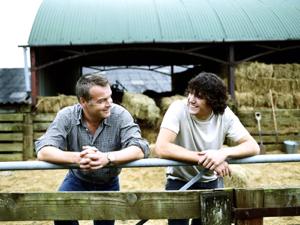Learning how to adapt boardroom strategies to the farm could earn you the best of both worlds

We all think of pinstriped suits and ivory towers when we hear the word “boardroom.” But with more family-owned farms getting more complex, maybe there’s something here we can borrow from the corporate world’s playbook to do better business on the farm.
“There are a lot of board governance practices, and even just corporate practices that can be applied to a family farm without it being so formal and intimidating,” says Jennifer Wright, senior human resources adviser with the Canadian Agricultural Human Resource Council (CAHRC).
As farm operations continue to grow, Wright says, more operations have multiple family and also non-family members, which add more levels of complexity but also increases the resources that management can draw on.
“It’s important,” Wright says, “to run the farm as a business with a more formal, professional structure.”
1. Delegate, delegate, delegate

Governing and corporate boards also often set up subcommittees, which give the opportunity for the group as a whole to save time and energy by delegating one or two people to handle a specific issue or area or responsibility and report back to the rest of the group. A good example would be purchasing a new piece of equipment.
“If, for example, you establish an equipment management committee or whatever you want to call it, you can pass off the responsibility to those two or three people who are taking care of that, and have the expertise to look into options and report back to the board or management group that need to make the purchasing decision,” says Wright.
“If others have ideas, they can share them with those committee members instead of having six or eight family members out there trying to do due diligence on all the same issue.”
2. Have someone in control

A lot of board practices can translate well to farm meetings. Appointing a chair, taking minutes (or at least recording decisions made at meetings), scheduling regular meetings, having an agenda, and setting a start and end time for meetings can help keep everyone on track.
That said, not too many family farms have adopted many of these practices, although they are well established in businesses of all sizes in other industries. “I know a lot of smaller businesses and even larger businesses that have teams that run meetings,” says Wright. “Sometimes the chair is a rotating chair, so everyone plays that role at some point. That’s one way to ensure that everyone’s involved, especially if you’re working with a family, so no one is always dominant in that situation. But no matter who plays that role, you have to ensure that they garner a level of respect from everyone at the meeting, and that everyone understands they do play a leadership role in that circumstance.”
At one time or another, almost everyone has suffered through a meeting that they were sure would never end because it had been hijacked by a couple of talkers who like to take the discussion off on tangents that have no relevance to the issue at hand.
Obviously the chair plays a vital role in keeping a meeting on track, and has to be comfortable exercising authority over the participants, but arming that person with agendas and timelines makes the task a lot easier.
3. Set an agenda

An agenda, if it’s used properly, can help keep the meeting focused, and save everyone a lot of time and frustration. “With an agenda everyone knows what’s going to be discussed and in what order it’s going to be discussed,” says Wright. “It serves to formalize things and to make sure that what’s being discussed is concise and focused, and that all the other things that you might want to talk about, that aren’t really related to the agenda can be talked about at another time. By having an agenda people’s expectations for what’s going to be discussed in a set time is clear and the person leading the meeting can always draw back to it. It sets clear expectations before anyone even comes into the meeting.”
4. Figure out what kind of meeting you need

Within any family business structure, there are likely going to be meetings of different kinds. Senior management meetings might be held weekly and involve only the people responsible for day-to-day operations, although in the case of family farms these can also be owners or shareholders. Management meetings, whether held in an office or around the kitchen table, are designed to make sure the operation runs smoothly on a daily basis by keeping everyone in touch with what’s happening, what’s coming up, and what needs to be done.
“If we’re talking about just the operation of the farm and how that senior management group meets, what’s most important is that it needs to agree, as a group, who’s taking the lead and what the structure is,” says Wright. “It’s a governance cycle which can apply to a senior management group as well as a board. There’s governance training out there by a number of different organizations but the key things are to have an agenda, take minutes, and understand everyone’s role at the meeting.”
Board meetings can also involve senior managers, but will almost always include the shareholders or owners of the business, and there can often be outside people such as financial or legal advisers sitting in as well.
5. Define responsibilities

On most farms — especially family-owned operations — roles and responsibilities often seem to just evolve over the years, but it’s easy to take for granted that everyone understands these roles and responsibilities. That may not always be the case, especially for new employees or family members coming into the business, or even as the farm grows and technology, crops, or farming practices change. Defining how the business is organized, and who does what in a more formal way creates more clarity for everyone, and helps it function more efficiently. “If responsibilities are defined within meetings and within the organization, then it’s clear. If one brother or sister is supposed to be in charge of equipment and another brother or sister is in charge of HR, it gives you a point to draw back to,” says Wright. “If someone has an opinion about a certain area they know who is responsible and who to approach. Just like any business, if the manager of product development needs to hire people, he or she will connect with the manager of HR, and so that structure can also be set in place within a farm organization.
“I believe it’s important to put some formal structures in place similar to any other business. There are things that you can put in place that aren’t as formal as a board, like an advisory group that brings in some third party, or outside expertise and provides the business with advice,” says Wright. “Maybe that’s something that some family farms want to consider, depending on the size of the farm, just so that they’re not always talking amongst themselves.”
6. Consider an advisory board

Some distinctions between an advisory board and a board of directors are important to note. A board of directors has fiduciary responsibilities, and it is responsible to all of the shareholders, whereas an advisory board is responsible only to the person who appoints it — usually the owner or CEO of the business. A board of directors expects staff or senior management to carry out its decisions. An advisory board is there only to offer advice and it’s up to the owner or CEO of the business to decide whether or not to implement any recommendations the advisory board makes.
Advisory boards don’t have to be permanent. They can be set up for a specific period of time or to deal with a specific subject. As an example, if the farm business is diversifying into direct marketing of its value-added products, it may want to consult with people who have experience with retail sales or marketing to help it make a marketing plan. Once that advisory board has provided the information and recommendations that the business needs, it can dissolve.
“A board of advisers is an interesting proposition because you can bring in people who are helpful in areas where you need advice and help,” says Larry Martin, principal of Agri-Food Management Excellence. “You may want a finance or marketing person, someone with a technical background or someone who could help with transition planning. It’s a really good concept, but not many farm businesses right now are using it.”
7. Get impartial advice

Wayne Gale, president of Stokes Seeds in Thorold, Ont., got the idea of creating an advisory board through his involvement with the Canadian Association of Family Enterprise (CAFE), a national, non-profit organization that supports and promotes families in business. Gale was just entering the third-generation, family horticultural seed business that his father, John had run since the ’60s, and felt they needed some third-party advice on different aspects of the business.
They brought in, and paid, three people with diverse business backgrounds — in agricultural business, manufacturing and insurance — to sit on the company’s advisory board and provide advice about everything from marketing to succession planning. “When they started with us they knew nothing about our business so they were impartial,” says Gale. “They stayed with us for about 10 years. They were a sounding board for our ideas, and gave us confidence to make changes in the business that weren’t always pleasant, or what we wanted to do. The advisory board gave us the reassurance that we were doing the right thing and sometimes coached us to listen to each other’s point of view. It really helped us a lot in figuring out our roles in the company.”












